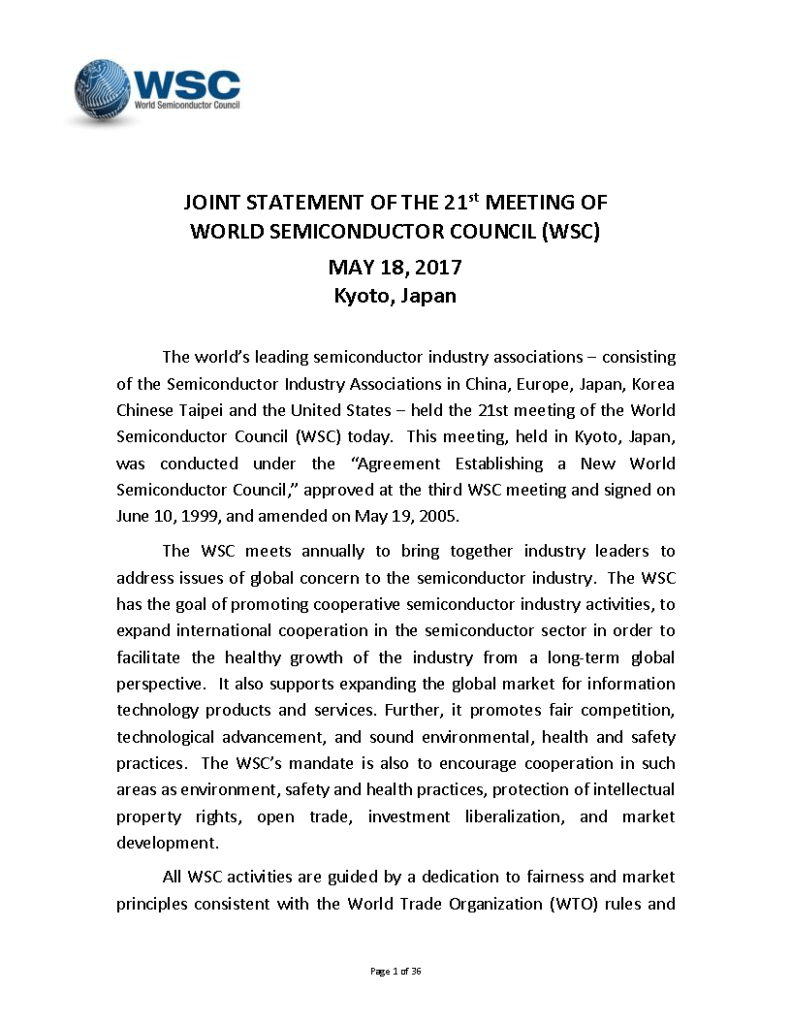Global Semiconductor Leaders Reach Agreement on Policy Agenda
Friday, May 19, 2017, 8:32pm
by Semiconductor Industry Association
WORLD SEMICONDUCTOR COUNCIL TO PRESENT PROPOSALS TO GOVERNMENTS
WASHINGTON—May 19, 2017—The Semiconductor Industry Association (SIA), representing U.S. leadership in semiconductor manufacturing, design, and research, today welcomed recommendations agreed to by global semiconductor industry leaders at the 21st annual meeting of the World Semiconductor Council (WSC) this week in Kyoto, Japan. The agreement sets forth a series of policy proposals to strengthen the industry through greater international collaboration. The WSC is a worldwide body of semiconductor industry executives from China, Chinese Taipei, Europe, Japan, Korea, and the United States that meets annually to address issues of global concern to the semiconductor industry. Recommendations from this year’s meeting are included in the 2017 WSC Joint Statement.
“The World Semiconductor Council is a unique and effective forum for semiconductor leaders from around the world to collaborate in support of mutually beneficial policies,” said Tunç Doluca, president and CEO of Maxim Integrated Products, Inc. and 2017 SIA chairman. “Global trade has delivered vast economic and societal benefits through increased accessibility, affordability, and adoption of faster, cheaper, and more capable semiconductor-enabled devices. The recommendations set forth by the WSC this week will help ensure free and fair trade, expand consumers’ access to technology, and strengthen the global semiconductor industry well into the future.”
The WSC this week reaffirmed one of its core missions: to ensure government policies are guided by market-based principles. To that end, industry leaders adopted a set of guidelines and best practices on how to implement semiconductor support programs that are consistent with international rules and avoid harmful trade distortions. The WSC also committed to continuing dialogue with relevant governments to promote fair, transparent, and non-discriminatory practices about government support programs.
Additionally, the WSC this week reaffirmed its commitment to actively encouraging additional countries to join the expanded Information Technology Agreement (ITA) and highlighted the importance of existing signatories fulfilling their ITA obligations. The expanded ITA, which took effect on July 1, 2016, covers an estimated $1.3 trillion in global sales of tech products and eliminates tariffs on new and innovative semiconductor products, including multi-component semiconductors (MCOs). This was the first expansion of the ITA since 1996, when the agreement was originally concluded.
In addition to the action taken on regional support programs and ITA expansion, industry leaders in attendance also made significant progress in the following areas:
Encryption – Ensure open global market access for commercial encryption products by advocating for WSC encryption principles to be included in trade agreements being negotiated or contemplated by WSC governments/authorities.
Protection of Intellectual Property – Support efforts to further strengthen the protection of trade secrets and improve patent quality.
Semiconductor Customs Classification – Pursue a long-term initiative to simplify the definition for semiconductors in the World Customs Organization (WCO) Harmonized System (HS) to avoid differing interpretations and classification inconsistencies across regions.
Anti-counterfeiting – Strengthen cooperation with global customs and law enforcement agencies to combat semiconductor counterfeiting.
Environment, Safety and Health – Continue successful efforts to reduce the industry’s PFC (perfluorocompound) emissions, increase energy efficiency, and highlight the industry’s successful efforts to manage chemicals used in semiconductor manufacturing.
Industry officials from the six regions represented in the WSC will deliver these recommendations to an annual meeting of their governments, called the GAMS, set to take place in Busan, South Korea the week of Oct. 30. The GAMS meeting provides an opportunity for industry to convey the importance of implementing the recommendations and explore areas of mutual interest with governments worldwide.
“The semiconductor industry is highly globalized and dependent on a complex and constantly evolving international supply chain,” said John Neuffer, president and CEO, Semiconductor Industry Association. “The WSC demonstrates our industry’s unparalleled commitment to international collaboration, and its 2017 recommendations will benefit governments, industries, and consumers across the globe.”
For more information on the Semiconductor Industry Association, visit www.semiconductors.org.
For more information on the World Semiconductor Council, visit www.semiconductorcouncil.org.
About SIA
The Semiconductor Industry Association (SIA) is the voice of the U.S. semiconductor industry, one of America’s top export industries and a key driver of America’s economic strength, national security, and global competitiveness. Semiconductors – microchips that control all modern electronics – enable the systems and products we use to work, communicate, travel, entertain, harness energy, treat illness, and make new scientific discoveries. The semiconductor industry directly employs nearly a quarter of a million people in the U.S. In 2016, U.S. semiconductor company sales totaled $164 billion, and semiconductors make the global trillion dollar electronics industry possible. SIA seeks to strengthen U.S. leadership of semiconductor manufacturing, design, and research by working with Congress, the Administration and other key industry stakeholders to encourage policies and regulations that fuel innovation, propel business and drive international competition. Learn more at www.semiconductors.org.
